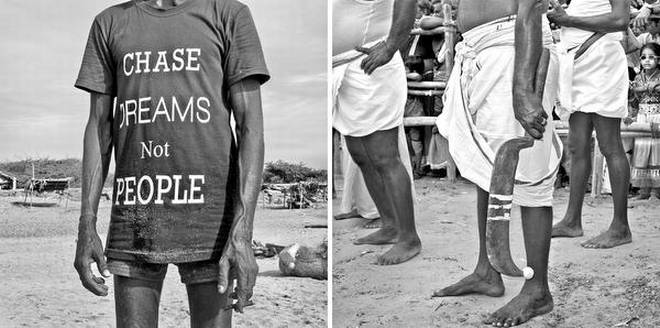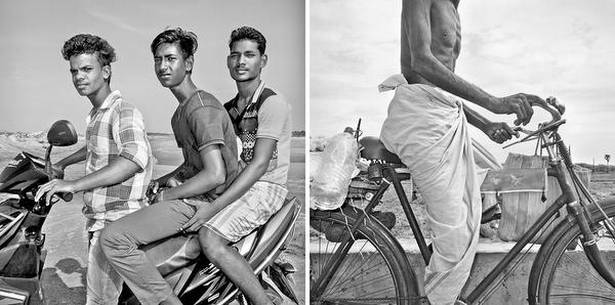TAMIL NADU / Mattancherry, KERALA :

Soumya Sankar Bose and Abul Kalam Azad situate the traditional within the contemporary in their works
Two India Foundation for the Arts (IFA) grantees, Soumya Sarkar Bose and Abul Kalam Azad, have interpreted tradition through an artistic and sociological lens in their works, which was recently displayed in an event, at the Park Hotel in Bengaluru.
In 16th Century Bengal, Jatra was a popular performance art. Soumya, who studied at Pathshala Media Institute, Dhaka, and was awarded the Emerging Photographer Of The Year Award in 2015, presented by Tasveer-Toto Funds the Arts, has captured the lives of Jatra artistes in their present context. “Jatra artistes now work in other jobs, in factories, in garages, as farmers. So in my photographs I have them portray their characters in the place they are in now,” says Soumya, who began work on this project in 2013.
“My uncle Dhirendranath Dhirde was a Jatra artiste. I recently met him before he passed away,” says Soumya, explaining how the idea for his Jatra series came about. “In the 16th and 17th centuries Jatra was famous. The common people would immediately identify a Jatra artiste from the mythological characters they portrayed. But from the 1980s and 1990s the art form declined with competition from other modes of entertainment.”
Another reason for the decline of Jatra, Soumya says, is the Partition of Bengal. “Artistes in Bangladesh stopped playing Hindu mythological characters and in West Bengal they stopped essaying Muslim characters like Akbar and Siraj-Ud-Daula.” With his second grant from IFA, Soumya says he organised a street exhibition in Bengal. “Crowds gathered around and people recognised a prominent Jatra personality — Bela Sarkar from the pictures.”

Jatra today, says Soumya, portrays stories from Bollywood or serials. “It has lost its former glory.” Asked why he chose to create black-and-white images, Soumya says: “I don’t believe in distinctions of black-and-white and colour. But I did want my pictures to give a feel of the past.”
Soumya says his photographs are hyper realistic. “I staged and framed my work with the Jatra artistes. We decided on where the picture will be taken and how. It was a 50-50 per cent effort from both the artistes’ and my side.”
Abul Kalam Azad’s work, on the other hand, is inspired from the Tamil epic Silappadikaram (The story of the anklet). Abul, a former photo journalist, says the epic was written by Ilango Adigal. “It was written in the Sangam era. An astrologer had predicted that Prince Ilango would die an early death so he became a Jain monk.”
Abul was raised in Mattancherry, Kerala and says that his interest in Silappadikaram developed as a child. “I wanted to return to my roots. My grandfather and father are Tamilians. Silappadikaram was in our library. I found it interesting because it was the only text that talked about the local people and their customs.”
His black-and-white photographs place the epic within contemporary times. The photographs he displayed at the event was of the men of Poompuhar or Pukar, a village in Tamil Nadu, the third part of Abul’s ongoing series titled Song of love, desire, agony. “Since Ilango explained the lifestyle of the people during the Sangam era, I wanted to explore what they look like today.”
The result is a stunning series of photographs, comprising statues and places of the era that still stand and portraitures of men from different backgrounds, castes, communities and classes.
“I am not the kind of photographer who will take a picture of a person without any thought. I approached each of my subjects, took their permission to photograph them and developed personal bonds with them.”
source: http://www.thehindu.com / The Hindu / Home> Entertainment> Art / by Sravasti Datta / March 06th, 2018








